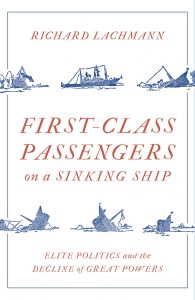A specter is haunting the United States—the specter of decline. Discussion of decline leapt in 2016 from academic treatises to the forefront of public debate as the winning presidential candidate made his slogan “Make America Great Again,” which implied America was no longer great, as it once had been. Trump built his platform on the notion that drastic action was needed to recover from a decline brought on by America’s own government. The 2008 crisis and the government’s response made obvious the extent of economic and political inequality in the United States, and the absolute decline in wealth and well-being for a growing fraction of Americans.
Evidence of decline is manifest to those of us living in America in the first decades of the 21st century. Spending on infrastructure has stagnated as bridges collapse, water and sewer pipes and dams burst, air and road traffic become ever more snarled, and passenger trains on a shrinking network struggle to reach early 20th-century speeds.
From the arrival at the airport to the high-speed train or subway trip into town, a visit to most countries in Europe and East Asia can seem to an American like a journey to a Tomorrowland, never to be realized in the United States outside of Disney World.
Student achievement at the primary, secondary, and university levels has fallen from the top ranks. US students, who attend ever more decrepit schools, are performing less well than their peers in countries with much lower levels of income or educational spending. The United States, which pioneered mass higher education with the GI Bill of 1944 and held the lead in the percentage of its population with university degrees for the following five decades, has now fallen to fourteenth among developed nations.
The United States does spend lavishly in two sectors, health care and the military, but its relative standing in both realms has been falling for decades. The United States is now thirty-fourth among nations in life expectancy. Beckfield and Morris report,
People living in the United States today can expect to live shorter and sicker lives, compared to people living in any other rich democracy. This “health gap” between the US and its peer countries is growing over time, as Canadian, British, Australian, French, German, and Swedish death rates among people aged 45–54 continue falling, and the US fails to keep pace with such changes . . . the US level of [health] inequality is far higher than we observe in most European countries, and the prevalence of poor health is on par with the former Soviet-bloc states of Central and Eastern Europe.
This is the case despite the fact that medical spending in the US was 17.1 percent of GDP in 2013, almost 50 percent above the next highest country, France, at 11.6 percent. Per capita and adjusted for differences in the cost of living, the United States spent $9,086 in 2013, 44 percent above the runner-up, Switzerland, at $6,325.
Why does the United States get such a poor return on its health care spending, or, to ask the question another way, why is it so expensive to provide worse care than people get in other wealthy and not-so-wealthy countries? It is not because Americans use so much health care; Americans, in fact, go to the doctor less and spend fewer days in the hospital than people in other OECD countries.
America is unique among the world’s dominant powers of the past 500 years in its repeated failure to achieve military objectives over decades.Instead, Americans pay much more for doctors, drugs, medical devices, and hospital stays than anywhere else on Earth because Congress has repeatedly rejected cost controls and forbids the federal government from negotiating prices. America also devotes more than twice as large a share of its medical spending to administrative costs as any other OECD nation.
This is so because multiple for-profit insurance companies, each with their own set of procedures and reimbursement schedules, need to hire armies of administrators to process their distinctive forms, while hospitals and doctors’ offices hire medical “coders” who seek to classify the care provided to patients in ways that maximize reimbursements, leading insurance companies to hire yet more administrators to check and challenge the bills submitted by hospitals and physicians. Of course, none of that contributes in any way to patients’ health and longevity.
The US military has become ever less able to win wars, even as its advantage in spending and in the amount and sophistication of its armaments has widened over its actual and potential rivals to a level unprecedented in world history. America’s only unambiguous military victories since World War II came in the first Gulf War of 1991, a war with the strictly limited objective of expelling Iraq from Kuwait, and in various “police actions” against pathetically small and weak opponents in the Dominican Republic in 1965, Grenada in 1983, and Panama in 1989.
The US war in Korea had an ambiguous result, while Vietnam was a clear defeat. In both those wars, the United States faced significant enemies backed by the rival superpower, and in Korea fought hundreds of thousands of Chinese troops as well. None of those conditions hold for the wars in Iraq and Afghanistan, which, even though they did not end in outright defeat, failed to achieve most of the objectives for which they were fought.
Any single defeat can be attributed to particular and ad hoc circumstances, but America is unique among the world’s dominant powers of the past 500 years in its repeated failure to achieve military objectives over decades. Those failures are even more extraordinary because they occurred in the absence of a rising military rival and as America’s ability and willingness to produce and pay for the weapons needed for military supremacy remained undiminished.
Outside of the lavishly, if ineffectively, funded military and medical realms, the outlook is bleak. At the very moment when further investment is needed for infrastructure, scientific and industrial research and development, education, and environmental repair, the capacity of the federal and of state and local governments to muster those funds is weakening.
Following the Bush tax cuts, federal receipts fell in 2004 to 16.3 percent of GDP, the lowest level since 1951. To hold spending steady as tax revenues decline, public debt has increased vastly since 2000, mirroring American families’ use of credit to sustain their spending in the face of stagnant incomes. Federal debt as a percentage of GDP more than doubled from 31.7 percent in 1981 to 67.7 percent in 2008, and then after the Great Recession, federal debt further increased to 101.8 percent of GDP in 2015.
Private debt, held by individuals and firms, increased as a percentage of GDP at an even faster rate in those three decades, and right before the financial crisis totaled four times the federal debt. “Between 2000 and 2007—the total [of household debt] doubled to $14 trillion and the household debt-to-income ratio skyrocketed from 1.4 to 2.1.” However, the fastest increase in debt was on the part of financial firms, which rose from 19.7 percent of GDP in 1979 to 117.9 percent in 2007.
Many commentators have described America’s decline, and many have proposed solutions. America’s loss of military and economic supremacy, and its citizens’ continued fall from the first rank in education, health, and well-being, have been accompanied by numerous suggestions of policies that could reverse the process. Yet increasingly those proposals are put forward with a resigned belief that they will not be heeded because the United States is no longer capable of mustering the political will to actually appropriate the revenues needed and has lost the organizational capacity to bring large-scale projects to completion. In essence, American progressives and realists express political options as a series of regrets:
Yes, we know the economic leader of the 21st century will develop a green energy sector, and that to do so will require massive governmental investment, efficiency mandates, and taxes on fossil fuels, but America lacks China’s resources and the EU’s willingness to tax and regulate, so such a sector cannot really grow here.
Of course, we understand that a government-directed and -financed universal health care system is the best (perhaps the only) way to lower health care costs and improve outcomes, but the insurance, pharmaceutical, and hospital industries will never allow that here, so America will have to continue to pay more for worse outcomes.
Every country with better educational results has a single national system and recognizes teachers’ professional worth with high levels of autonomy and pay, but America has a tradition of local control, and in any case we can’t afford to pay enough to get capable professionals, so we had better settle for closely supervising teachers by testing their pupils on basic academic skills, even though students who pass those tests are not prepared for university education or international competition.
When commentators do not fall into despair about the consequences of a supposedly unique American approach to politics and governance, they indulge in magical thinking, hoping for a savior or for the spontaneous eruption of a social movement. Barack Obama certainly embodied such hopes in 2008 as his supporters projected onto him personal qualities that would allow him to single-handedly overcome partisan divisions and enact needed reforms. Obama returned the favor, telling those who attended his rallies, “We are the people we have been waiting for.”
Ralph Nader’s book Only the Super-Rich Can Save Us!, a utopian novel that imagines billionaires undermining corporate power and revitalizing citizen action, shows the extent to which progressive plans are based on hopes for elite generosity rather than realistic plans for political mobilization. It is especially revealing, and depressing, that this book was written by the American who has been more successful than any other at building citizen organizations over the past half century.
In any case, the contributions from liberal billionaires such as Tom Steyer, a hedge fund manager who spent tens of millions of dollars in the 2014 and 2016 elections on ads criticizing Republican climate change skeptics to little effect, were overwhelmed by spending from the Koch brothers and their allies for federal and state-level candidates committed to gutting environmental protections, weakening unions, and making it difficult for African Americans and other Democratic constituencies to vote in future elections.
“Tea Party” adherents believed that by electing a collection of retired corporate executives, self-satisfied heirs, career politicians, and assorted oddballs they would achieve a dramatic reduction in government spending that would revive the economy while returning government to what they imagine the Founding Fathers intended when writing the Constitution.
Periodically, a new third party is seen as the engine of change. Before he placed his hopes on the superrich, Ralph Nader thought that his third-party presidential candidacy would disrupt the two-party duopoly on power and, in some never-specified way, open a space for progressive politics. Thomas Friedman, the most prominent US newspaper columnist of the early 21st century, advocated for a third party on the stage of the next presidential debate to look Americans in the eye and say: “These two parties are lying to you. They can’t tell you the truth because they are each trapped in decades of special interests. I am not going to tell you what you want to hear. I am going to tell you what you need to hear if we want to be the world’s leaders, not the new Romans.”
Even when political hurdles are cleared and a new program is instituted, the state’s weakened organizational capacity hampers implementation.Friedman does not explain how such a party would be organized, or how it would finance itself while flouting the “special interests” that fund the two existing parties. Nor does he discuss how and why a third party would be able to overcome the obstacles that Obama, who also pledged to tell the truth, challenge special interests, and overcome gridlock, was unable to surmount.
Tea Party activists, though they in fact operate within the Republican Party, believe that a new, purer party could renew the nation in (unspecified) ways that even a purged and revitalized Republican Party cannot achieve.
Another popular trope finds the potential for political transformation in new technologies. Claims that the internet (or Twitter or cell phones) might foster effective political movements that can replace defunct or shrunken unions and mass organizations have yet to be realized. Nor is Donald Trump’s use of Twitter a sign that it can serve as an organizing tool. Twitter worked for Trump because “one group is as intoxicated by Twitter as Mr. Trump is: journalists.” Thus, old-style broadcast media amplified each of his tweets, ensuring that “the social media platforms that were once heralded as democratic tools could also be used to undermine democratic norms.”
So far, the internet is most effective as a fundraising tool, as was the previous technological innovation, direct mail, which was pioneered in George McGovern’s 1972 presidential campaign. Yet, the funds raised online or through the mail continue to be overwhelmed by money collected the 19th-century way, from corporations and wealthy individuals that buy the votes of candidates and officials of both parties.
Even when political hurdles are cleared and a new program is instituted, the state’s weakened organizational capacity hampers implementation. Compare Medicare, which went into operation, covering 19 million citizens, only 11 months after Lyndon Johnson signed it into law in 1965, with President Obama’s 2010 health care legislation. The recent law was written with a four-year delay before its government-supervised health care plans would take effect.
That long delay was partly an effort to game the accounting rules of the Congressional Budget Office but also reflected the president’s and Congress’s shared belief that the government could not implement such a plan any faster. That belief turned out to be more than justified when the Obama administration postponed the implementation of some elements of the law from 2014 to 2015 and the online system to register applicants for government-subsidized insurance failed to operate properly for several months.
Or, compare the 2009 stimulus with government jobs programs during the New Deal or with the 2009 stimulus spending in China. In the absence of agencies capable of preparing engineering or architectural plans and managing corps of newly hired workers, the “shovel-ready” projects undertaken in the US in 2009–10 were small-scale and incremental, focused mainly on repaving roads and repairing existing infrastructure, paying for existing state and local workers who otherwise would have been laid off, and passing out tax cuts to be spent on consumer goods in the private sector.
The sum effect of the stimulus spending was to merely slow the rapid decay of American Roads, bridges, dams, and schools, with virtually no progress toward building the new transportation, utility, and other networks needed for international competitiveness or even to sustain existing levels of economic production. The contrast with the monumental dams and other projects constructed in the New Deal, and with the high-speed rail lines, subways, airports, and city centers accelerated by the Chinese stimulus, reveal a decline in the capacity of the US government to plan and execute large-scale projects that parallels the loss of ability to administer benefits.
__________________________________

Excerpt from First-Class Passengers on a Sinking Ship: Elite Politics and the Decline of Great Powers by Richard Lachmann, published by Verso Books. Copyright © 2020 by Richard Lachmann.



